Disclosure: Meeple Mountain received a free copy of this product in exchange for an honest, unbiased review. This review is not intended to be an endorsement.
Every time I hear the term “civ game”, I laugh. You’d be surprised how many times in this day and age—where three-hour Euros are being distilled into 45-minute, rapid-fire strategy games—designers, publishers, and we the media try to frame a tabletop product with themes of technology development, historical context, culture integration and territory control as a “civ game.”
“Civ game” is the shorthand for a civilization game, the brand of day-long gaming experience that began for most people in one of two environments: either the Civilization video games first designed by Sid Meier and Bruce Shelley released in 1991, or the board game Civilization, designed by Francis Tresham and published in 1980.
My first civ game was the video game, and while I enjoyed Civilization, it was a lot, even for a kid who had all kinds of time on his hands. I think I only played Civilization because, at that point, I was already a Sid Meier video game junkie: I sank a billion hours (give or take) into Meier’s PC game F-19 Stealth Fighter. Sid Meier’s Pirates! was another title I hit hard in the late 1980s.
The Civilization video games and the Civilization board game have a lot of similarities. Civ games are all about building an empire—developing a community from something small to something massive. While there may or may not be armies to command, the most detailed civ scenarios involve building technology advancements like mathematics or advanced engineering or naval warfare or maybe even pottery, depending on the level of minutiae you are willing to manage.
Events come out of nowhere, events that shaped real-world history, and that are leveled against the players. Trading with other civilizations is vital to advance, and the civilization that can advance their people efficiently and balance a mix of things like military conflict, politics, trade and event management will usually win the game.
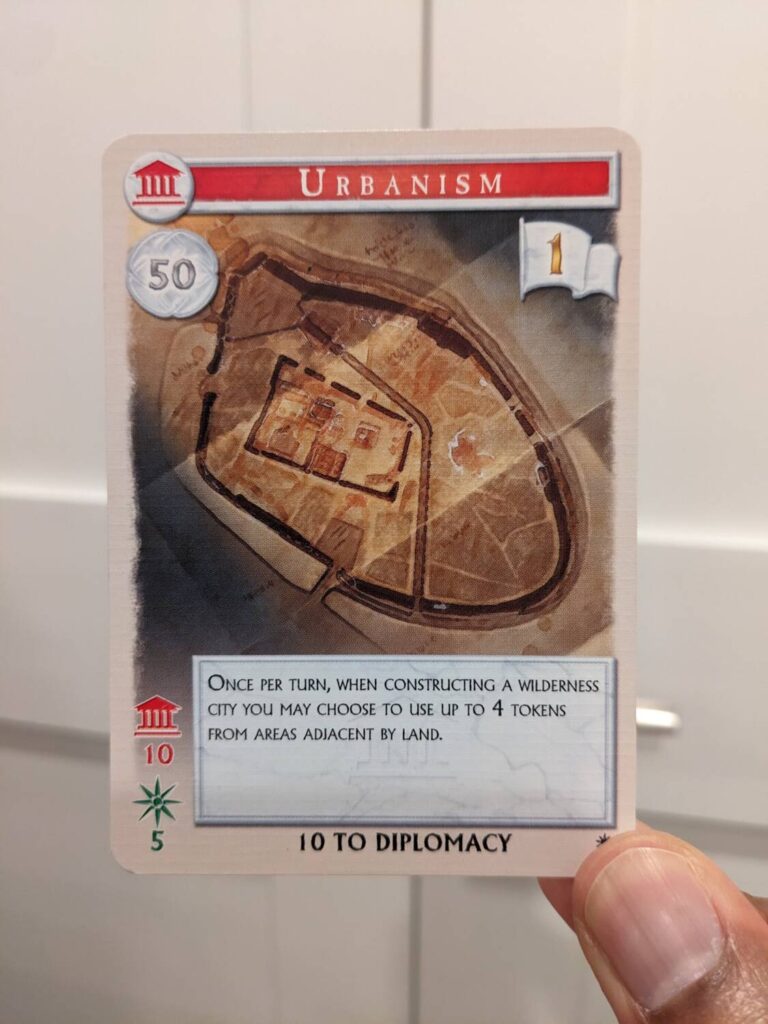
History of a Historical Game
Tresham (it is astounding that Tresham designed both Civilization and the games 1829 and 1830: Railways & Robber Barons, the foundational products of the 18xx system, isn’t it?) built a board game in Civilization that has stood the test of time.
The original Civilization featured what some media historians believe to be the first “technology tree” in board games. A tech tree is simply a way to describe a system (in this case, cards) where a player can acquire a low-level upgrade for their faction, then upgrade that technology and research new ones in the same technology family to gain advantages over their opponents. This allows players to specialize in certain areas, and by doing so, those players can receive discounts to higher-level techs in the same brackets of the tree over the course of the game.
Civilization was “enhanced” with the 1991 release Advanced Civilization, with a pool of ten designers collaborating to rework some of the original game’s technology advancements and trading systems. A further redesign, Mega Civilization, arrived in 2015 and allows up to 18 players to guide a civilization from the Stone Age to the Iron Age over a game that might last 20 rounds or more.
In most games, 20 rounds doesn’t sound too bad. In these civ games, 20 rounds might take the entire day. In extreme cases—especially if you somehow have 17 friends willing to go to town on this bad boy!—the game might take as long as two days to finish. During my first play of Mega Civilization last year, we played for almost 10 hours with eight players, and that was plenty enough for me. (You can click here to enjoy the drama of my first experience, right down to the moment I was handed an Iconoclasm & Heresy calamity in a trade that essentially ended my day.)
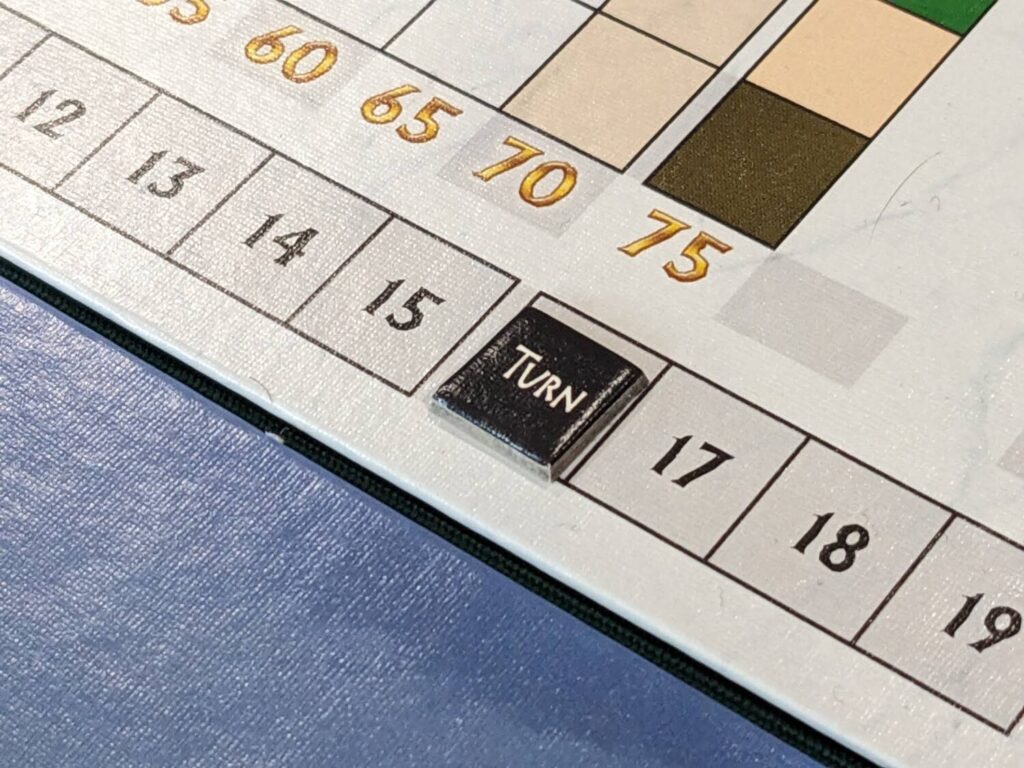
Mega Civilization was re-released in 2024 as Mega Empires and published by Ares Games. To eliminate any confusion, I want to state this now and repeat it throughout the review: The two Mega Empires boxes—The West and The East—are the same as Mega Civilization. I have now seen both an original copy of Mega Civilization (right down to the big, fancy wooden box) as well as my review copies of Mega Empires, and everything about both productions is the same, save for the artwork and titles on the front of the 2024 boxes.
Some players who have played Mega Civilization noted that the Mega Empires boxes are based on the 2019 release Western Empires and the 2021 release Eastern Empires, and that was confirmed by a “Design and Development Story” section in the rulebooks for Mega Empires. While I recommend owning a copy of this game if you align with my preferences detailed below, absolutely do NOT buy this game if you already own a copy of either Mega Civilization, Western Empires and/or Eastern Empires. THIS IS ALL THE SAME GAME SYSTEM!!
The new version has been split into two distinct SKUs: Mega Empires: The East and Mega Empires: The West. That’s because Mega Civilization was also split into two games with two different maps, but if you have 18 players and a couple days to play, you could put both maps together.
Believe it or not, I briefly tried to set up a game that big, but it would have required finding enough strangers to pair with my existing groups to make that happen. It is already hard enough to find people willing to give up their Saturday to play a single board game, so I bailed on that idea.
Maybe we should start there with this review—no matter what I think about the game, can you even find people willing to play it?
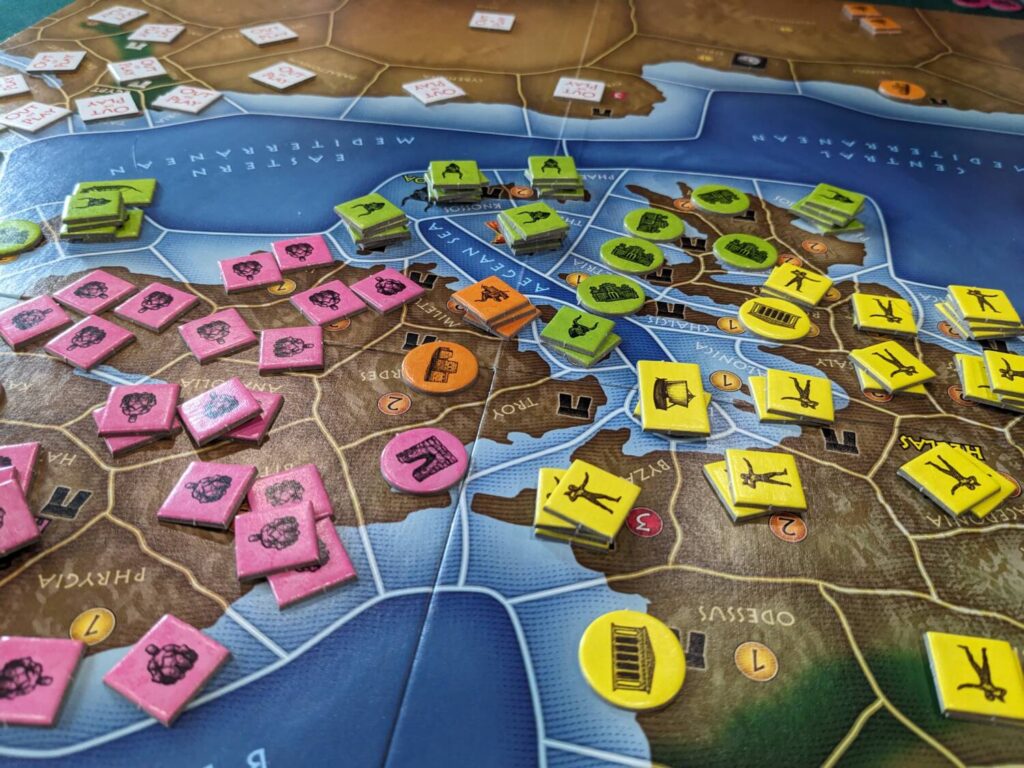
Mega, Mega, Mega
Mega Empires is a 3-18 player “civ game.” Each box accommodates up to nine players, so you’ll need both boxes if you really have enough people to do a larger game.
Some things to know:
- Mega Empires really does take about an hour per player, based on my three total plays of Mega Civilization games (one of Mega Civilization, then two of Mega Empires—one each of Mega Empires: The East and Mega Empires: The West). The “Short Game” is a variant that has a separate deck used to position all nine players in either game with certain technologies and pre-seated population on the map, but even that version is a 4-6 hour game.
- Mega Empires is an extraordinarily interactive trading game. Players will spend ten minutes in each round shouting in a room with other people who are shouting as everyone tries to collect sets of goods while also trading calamities that will negatively affect the calamity’s owner during subsequent phases in that round. Remember, that might mean negotiating as many as 20 times for 10 minutes a pop.
- Mega Empires is an event card game, something I usually do not like. Sometimes you will be dealt an untradeable calamity card called Civil War that will absolutely devastate your empire, especially if you are in the lead, offering a chance for a trailing opponent to power grab a bunch of your stuff by annexing some of your hard-earned cities. In other cases, you will be dealt a situationally-terrible calamity card, but it becomes a card that you might be able to trade to another player during the same trading phase.
- Mega Empires features conflict but it is NOT a war game. Sure, there is conflict from time to time, or pirates or even barbarian hordes that show up and wipe one of your wilderness cities off the map. Conflict here is deterministic—you’ll count off units from either side until one side remains as the winner, which is then left to hold a territory. More often than not, conflict allows a third player to swoop in and pick off remaining units—and in a game with a bunch of other players, you may not want to set up too many of those pesky neighbors!
Other logistical challenges persist for certain groups. Mega Empires is not a runaway leader game—in my play of Mega Empires: The West, four factions ganged up on the leader in a round to bring them back to the scoring pack—but Mega Empires is absolutely a game where I’ve seen players get two or three columns behind on the AST. Falling behind can be devastating if you can’t quickly get yourself back into the trade game.
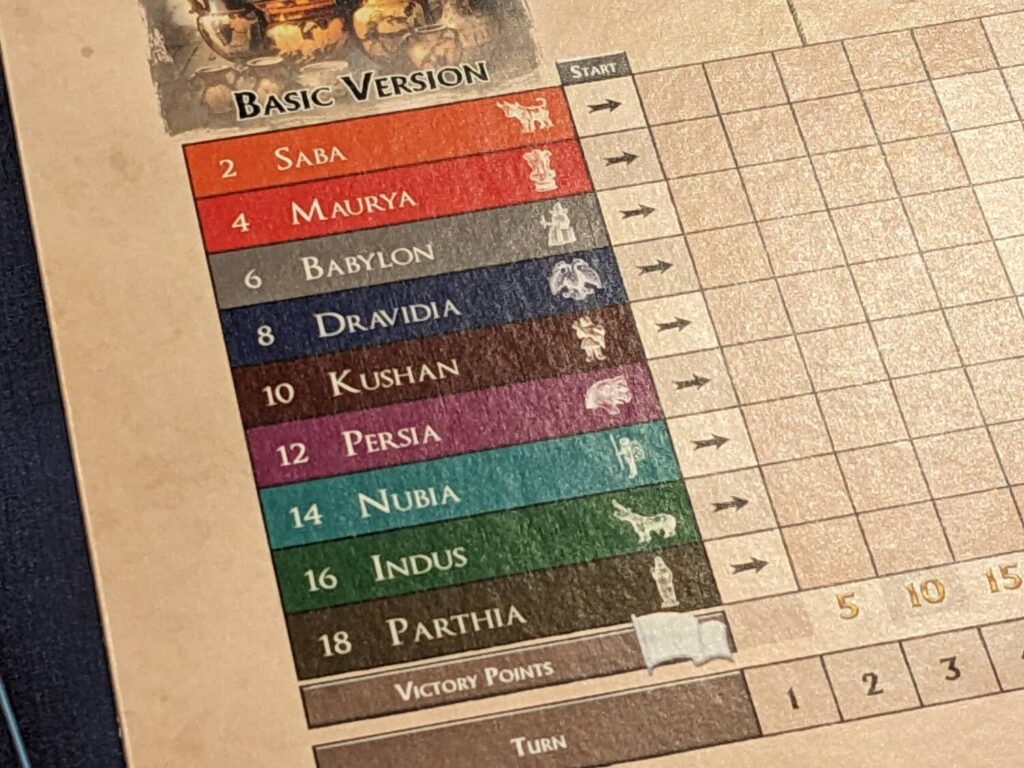
Mega Empires is also a “haves versus have nots” game when it comes to the trading phase. In the back half of each of my games, I have witnessed other players who are looking to trade low-level resources for mid-level resources, whereas others are trading with high-end commodities and dumping their crap on the bottom feeders in each game. It’s not a great feeling, now that I’ve been a part of both sides of that equation. That might not be for everyone!
All this means that Mega Empires is for a very specific audience. That Eurogame friend who prefers the heads-down strategy environment of nearly anything published by Garphill Games? I wouldn’t bother calling them. The person who isn’t interested in Sidereal Confluence-style trading rounds? I would leave them behind, too. The people who have busy weekends, usually playing the role of shuttle bus driver for their three kids who are on three different hockey teams that play in three different rinks around town? They won’t have the time to break away for a 12-hour, nine-player game on a Saturday.
And that’s before we talk about the emotional element that comes from getting punched in the face by both random and planned events during such a long game.
My first play of Mega Civilization was rough, friends. I spent most of my rounds in that game building back from two cities to get up to five cities, only to have a calamity knock out two or three of those same cities. Every time there was a non-tradable calamity in play, it seemed like I was dealt that card. I got victimized regularly during play by opponents—both in conflicts and in the trading game—and never built a level three advancement. I was involved in a conflict every round after play really kicked into gear.
I took a beating and didn’t sleep well after that first play. This, despite the fact that both the rules and the other players reminded me that that is what Mega Civilization is—it’s a series of roller-coaster rounds. Finding your way through the chaos and managing your emotions is actually a part of the gameplay. Can you continue to focus after an epidemic wipes out 15 of your empire’s strength points? Did a slave revolt just ruin your plans? Did piracy just knock you back on the AST?
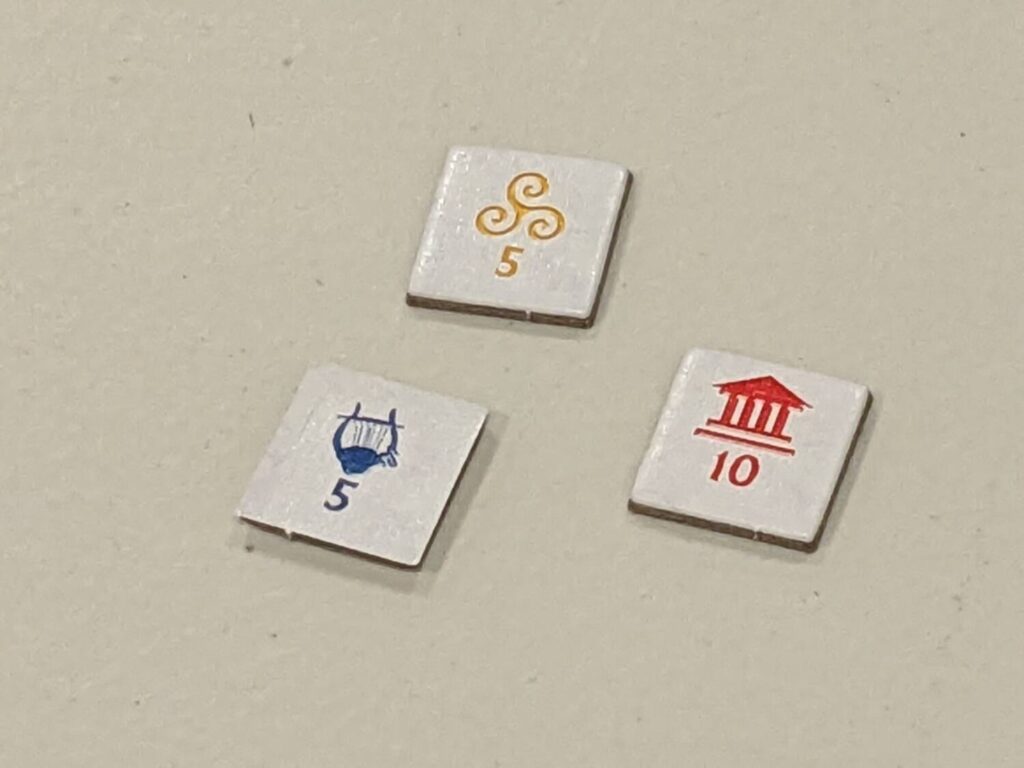
An Exceptional “Event Game”
Mega Empires is a niche of a niche.
A bit like the cult of High Frontier 4 All players in the world today, to people who put on costumes to do all-day games of Diplomacy, to those willing souls open to playing an 8-10 hour game of 1880: China with a bucket of poker chips and their six best friends all day on a Sunday afternoon, Mega Empires is a deep, deep dive.
And here’s what is shocking: Mega Empires is not a long day at the table because of a heavy rules load. Mega Empires (and the Civilization games in general) are rules-moderate experiences. For example, Unconscious Mind, Voidfall, Men-Nefer, and Galactic Cruise (to name just a few) all have significantly more rules than Mega Empires, so thankfully these “civ games” are games you can teach to almost anyone in about 15 minutes. In fact, the best way to learn Mega Empires is to just start playing it with one or two people who really know the rules well. Across each round’s 13 phases, you can almost learn the whole game simply by playing it, which most games don’t really allow for in a world where rulebooks are spinning out of control in terms of their length.
In fact, I intentionally did just that for my final review play of Mega Empires, using The East map. Along with six new players, we used the first 5-6 rounds as the game’s full teach, and got through the first 10 rounds in about three hours. Almost everyone had purchased one or two level-one Civilization Advances (techs) by the end of that partial play, we had done a few initial rounds of trading, and one or two of the players had their board position compromised by a mix of Slave Revolts, Volcanic Eruptions (earthquakes, in our case), and conflicts from neighbors.
Mega Empires is a niche of a niche because it requires such a massive time investment to finish. You’ll be lucky to play Mega Empires twice in a normal year. If you are one of the lucky ones who have a civ group that gets together monthly, you are truly a one percenter!
And despite the sheer lack of chances you will get to play a game like this, I still highly recommend a purchase if you think you have the group to play it. Even Sidereal Confluence—a game I played three times in a year once, which I still can’t believe—is worth owning if you have the right group for it, and Mega Empires falls into the same camp.
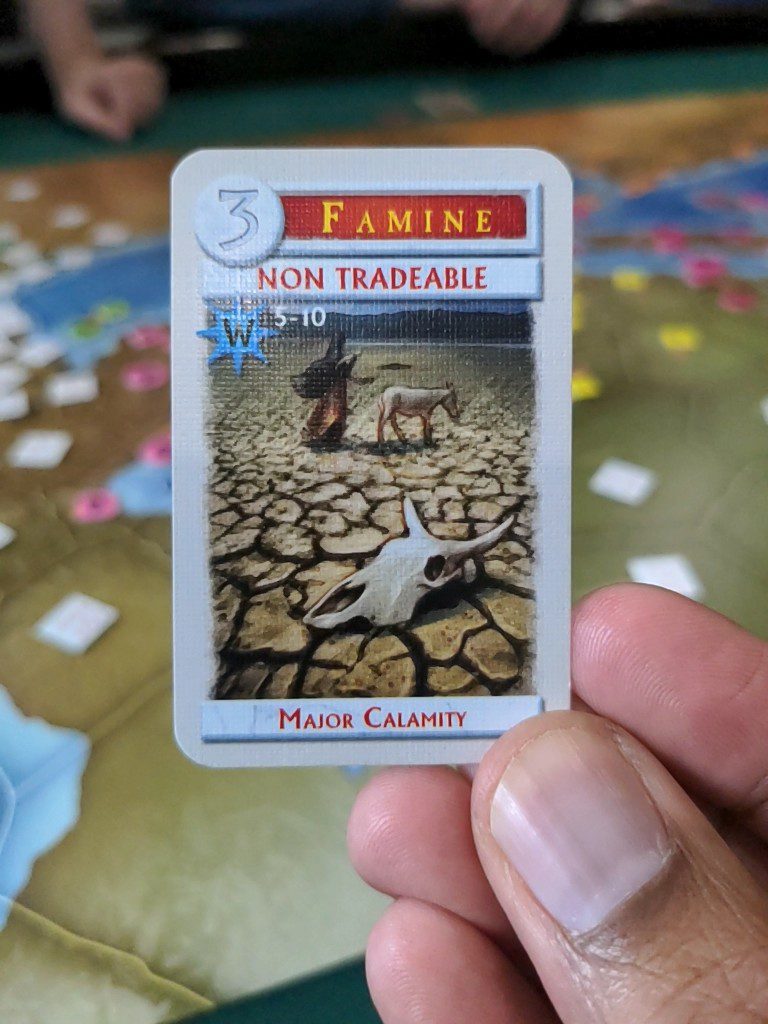
That’s because Mega Empires is an event. It is a blast to work the trading floor, trying your best to find sets of low-level resources to buy a Civilization Advance card in the same round where a player can advance on the AST only if they have three level one cards. It’s a blast to figure out a way around a pair of tough calamity cards to escape with only minimal damage…another place where the Civilization Advance cards come into play. It’s always interesting to negotiate with your neighbors—who double quite nicely as future conflict dance partners—to ensure you can get your empire up and moving before someone swoops in and takes some of your region’s territory to expand.
Balancing the growth of an empire with the lack of tokens in your stock is key, and that’s before you have to watch your stock to ensure you don’t have to endure a tax revolt. Leading an empire on the edge of the map looks juicy at first…until you realize that the only way to expand into regions with a larger population cap is to leave the juicy confines of your starting territory. There’s a lot to do here and even through three plays I am intrigued to revisit this for that once-a-year play with members of my gaming circles.
The “worst” thing about Mega Empires is the hurt feelings. Being on the losing end of a brutal, 10+ hour gaming experience is a lot to stomach. I had more fun being in the running for the game than being on the outside looking in, watching as trading partners laughed at the paltry resources I was peddling while they were off wheeling and dealing to make more interesting trades. That just means I have to play better, but that’s hard to say when you are deep in hour eight of a game with no end in sight.
One of the challenges with Mega Empires has been addressed with fans who have built spreadsheets that can be used to math out the discounts earned after purchasing Civilization Advance cards. For my two review plays, we did a mix—using a Google Sheets file built by one of the players to run one game, then using the game’s included chits to track discounts for my second game. Big edge to the Google Sheets file; players can run off to their laptop or phone and use better tools to ensure that they are spending the right amount of coin (or treasury tokens in a pinch), saving a lot of time in the process. I can’t imagine playing a full game without the Google file now that I’ve seen it.
Mega Empires is a blast, despite the sheer volume of barriers to entry because of the time commitment. If you have the right group, buy a copy stat!


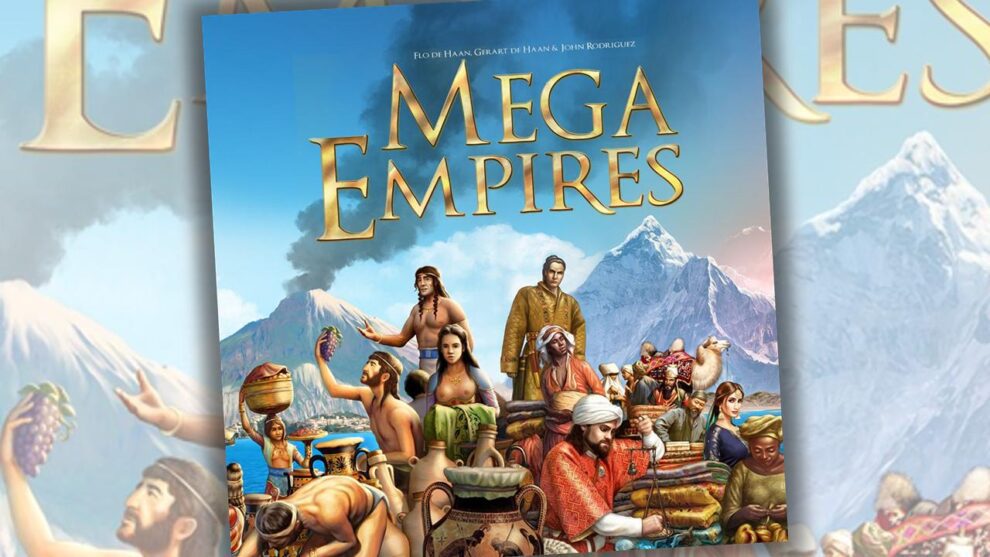










I so want to try this version of my old favorite. I just have no idea when or where I would get enough people together (and on enough frequency) to make the investment worth it.
Sigh.